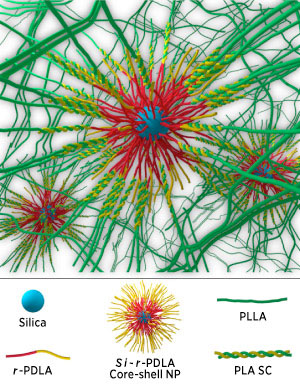| Posted: Oct 04, 2018 | |
Toughening up polymers with nanoparticles(Nanowerk News) A*STAR researchers have toughened up polylactic acid while maintaining its elasticity by adding core-shell nanoparticles as a filler (Composites Science and Technology, "Biodegradable silica rubber core-shell nanoparticles and their stereocomplex for efficient PLA toughening"). |
|
| Polylactic acid (PLA) is a biodegradable and highly biocompatible polymer with good thermal processibility, which has found widespread use in biomedical applications and as a packaging material. However, it is brittle and has poor mechanical stability, so it is often modified by adding reinforcing polymers and by incorporating different polymerization methods. Unfortunately, these modifications also reduce the material's strength and elastic modulus, which limits its applications. | |
| Now, Chaobin He, Beng Hoon Tan and colleagues at the A*STAR Institute of Materials Research and Engineering, Singapore, report the increased toughness of PLA, while maintaining the strength and modulus of the material, by the addition of core-shell nanoparticles as a filler. The nanoparticles have silica cores with rubber chains covalently linked to the silica, and poly(D-lactic acid) (PDLA) grafted onto the outer shell. These sequential steps were realized by using a technique called ‘ring opening polymerization'. | |
 |
|
| Polymeric nanocomposites comprising poly(lactic acid) with nanoparticles of silica-rubber-poly(D-lactic acid). | |
| On addition of the nanoparticles to a poly(L-lactic acid) (PLLA) matrix using a solution blending process, a complex forms between the pendant PDLA chains and the PLLA matrix. Interestingly, thermal analysis of the polymer nanocomposite indicates that the material reassembles perfectly after recrystallization from the melt. This melt memory effect is considerably enhanced by the incorporation of rubber chains in the nanoparticles. | |
| "The presence of silica-rubber-PDLA nanoparticles in the PLA matrix and its complex formation with PLLA provide stress relief and bridging effects during deformation, thus improving toughness without sacrificing strength and modulus,” says He. | |
| The increased facile stress relief is probably due to the ability of rubber to act as a stress concentrator during plastic deformation. From microscopic analysis of the polymer nanocomposite, the deformation mechanisms of the material were identified as ‘crazing’, which involves the formation of microvoids in the material, and fibrillation at sites of local plastic deformation. | |
| “The large scale production of PLA from renewable resources makes our environmentally-friendly material a promising candidate to replace petroleum-based thermoplastics,” says He. “While our approach has significantly overcome the shortcomings of pure PLA, such as brittleness and poor mechanical stability, further optimization of materials and process as well as enhancement in the nanoparticles-polymer matrix compatibility needs to be carried out.” | |
| “The ability to toughen PLA with the addition of these silica-rubber-PLA nanoparticles will pave the way for further development of sustainable polymers for wider applications, example, consumer electronics, automotive and packaging,” concludes He. | |
| The A*STAR-affiliated researchers contributing to this research are from the Institute of Materials Research and Engineering. |
| Source: A*STAR | |
|
Subscribe to a free copy of one of our daily Nanowerk Newsletter Email Digests with a compilation of all of the day's news. |
